Analysis of Healthcare Vaccination Systems in Developing Countries
VerifiedAdded on 2022/05/12
|9
|2348
|21
Report
AI Summary
This report provides a comprehensive analysis of healthcare vaccination systems, with a particular focus on developing countries. It begins with an introduction to vaccination and its importance in preventing infectious diseases, highlighting the cost-effectiveness of prevention. The report then compares vaccination systems in the United States, a developed country, with those in developing countries, specifically mentioning Afghanistan, identifying strengths, such as strong immunization routines, financial support, and research investments, and weaknesses, including political instability, poor infrastructure, and lack of resources. The report emphasizes the need for improved infrastructure, technology, and political stability to enhance vaccination programs. It also discusses the importance of proper vaccine storage, scheduling, and record-keeping. The report concludes by emphasizing the importance of information sharing, policy implementation, and international collaboration to improve vaccination coverage and reduce child mortality in developing nations. It also mentions specific strategies like new vaccine procurement systems and public-private partnerships to improve the quality of immunization systems.
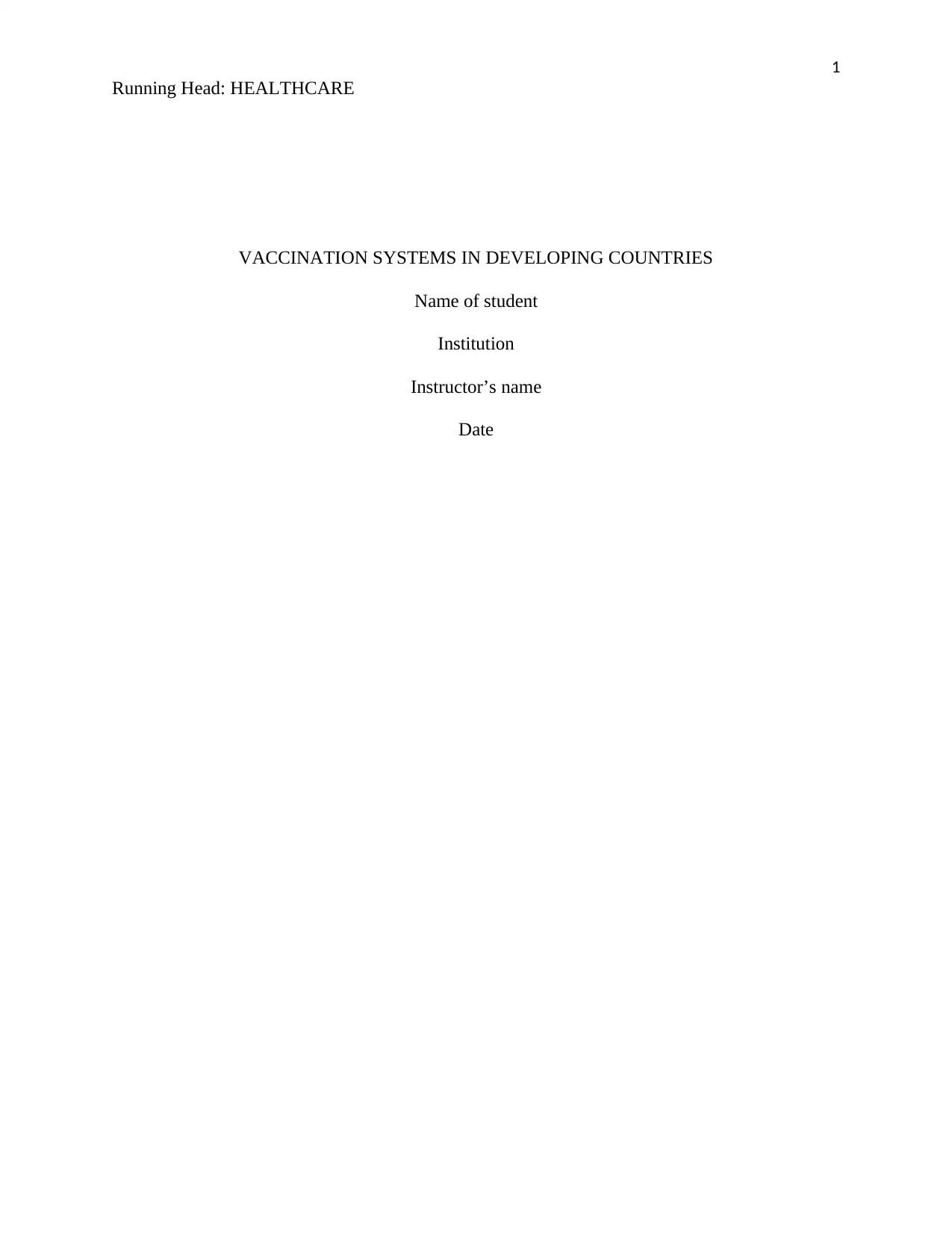
1
Running Head: HEALTHCARE
VACCINATION SYSTEMS IN DEVELOPING COUNTRIES
Name of student
Institution
Instructor’s name
Date
Running Head: HEALTHCARE
VACCINATION SYSTEMS IN DEVELOPING COUNTRIES
Name of student
Institution
Instructor’s name
Date
Paraphrase This Document
Need a fresh take? Get an instant paraphrase of this document with our AI Paraphraser
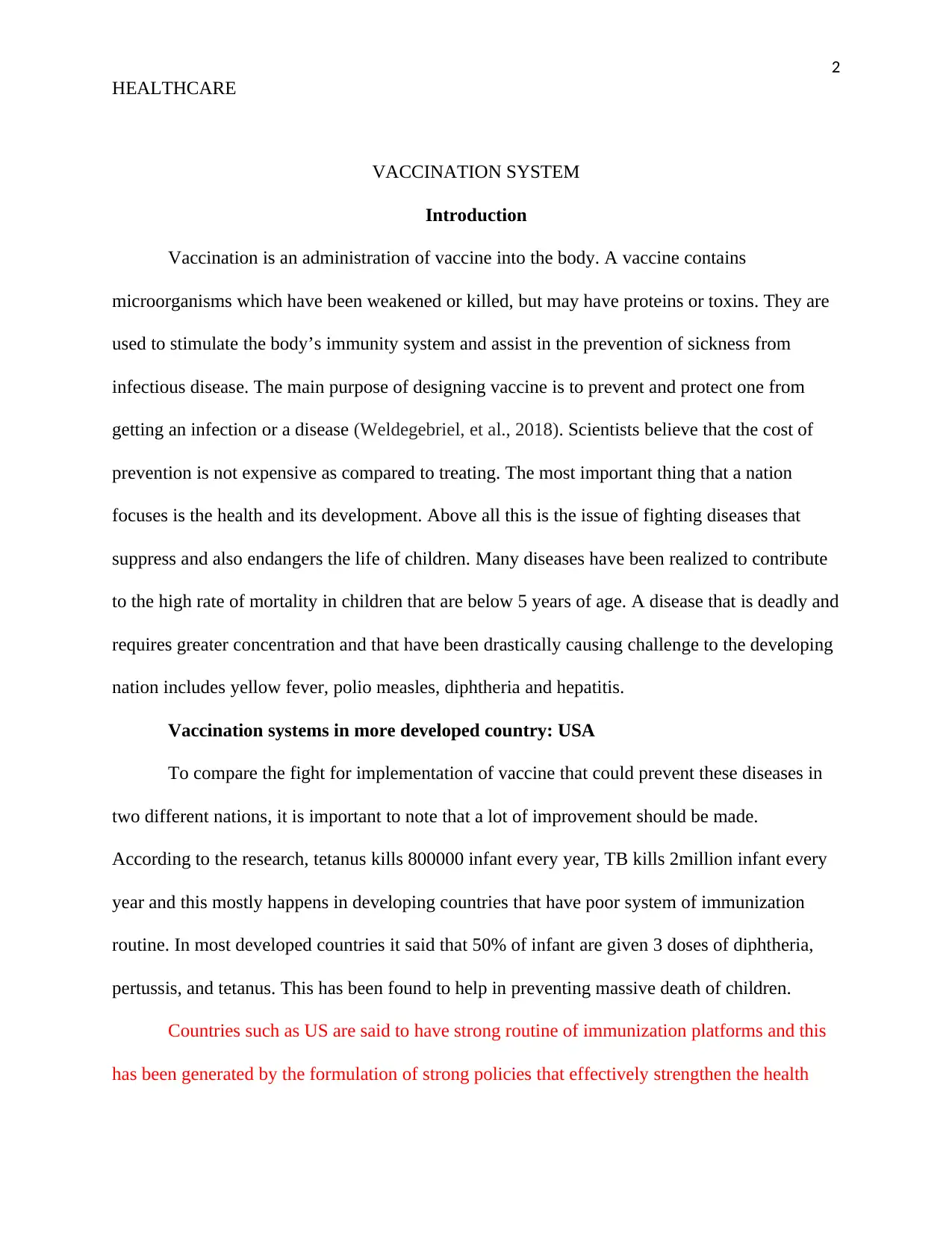
2
HEALTHCARE
VACCINATION SYSTEM
Introduction
Vaccination is an administration of vaccine into the body. A vaccine contains
microorganisms which have been weakened or killed, but may have proteins or toxins. They are
used to stimulate the body’s immunity system and assist in the prevention of sickness from
infectious disease. The main purpose of designing vaccine is to prevent and protect one from
getting an infection or a disease (Weldegebriel, et al., 2018). Scientists believe that the cost of
prevention is not expensive as compared to treating. The most important thing that a nation
focuses is the health and its development. Above all this is the issue of fighting diseases that
suppress and also endangers the life of children. Many diseases have been realized to contribute
to the high rate of mortality in children that are below 5 years of age. A disease that is deadly and
requires greater concentration and that have been drastically causing challenge to the developing
nation includes yellow fever, polio measles, diphtheria and hepatitis.
Vaccination systems in more developed country: USA
To compare the fight for implementation of vaccine that could prevent these diseases in
two different nations, it is important to note that a lot of improvement should be made.
According to the research, tetanus kills 800000 infant every year, TB kills 2million infant every
year and this mostly happens in developing countries that have poor system of immunization
routine. In most developed countries it said that 50% of infant are given 3 doses of diphtheria,
pertussis, and tetanus. This has been found to help in preventing massive death of children.
Countries such as US are said to have strong routine of immunization platforms and this
has been generated by the formulation of strong policies that effectively strengthen the health
HEALTHCARE
VACCINATION SYSTEM
Introduction
Vaccination is an administration of vaccine into the body. A vaccine contains
microorganisms which have been weakened or killed, but may have proteins or toxins. They are
used to stimulate the body’s immunity system and assist in the prevention of sickness from
infectious disease. The main purpose of designing vaccine is to prevent and protect one from
getting an infection or a disease (Weldegebriel, et al., 2018). Scientists believe that the cost of
prevention is not expensive as compared to treating. The most important thing that a nation
focuses is the health and its development. Above all this is the issue of fighting diseases that
suppress and also endangers the life of children. Many diseases have been realized to contribute
to the high rate of mortality in children that are below 5 years of age. A disease that is deadly and
requires greater concentration and that have been drastically causing challenge to the developing
nation includes yellow fever, polio measles, diphtheria and hepatitis.
Vaccination systems in more developed country: USA
To compare the fight for implementation of vaccine that could prevent these diseases in
two different nations, it is important to note that a lot of improvement should be made.
According to the research, tetanus kills 800000 infant every year, TB kills 2million infant every
year and this mostly happens in developing countries that have poor system of immunization
routine. In most developed countries it said that 50% of infant are given 3 doses of diphtheria,
pertussis, and tetanus. This has been found to help in preventing massive death of children.
Countries such as US are said to have strong routine of immunization platforms and this
has been generated by the formulation of strong policies that effectively strengthen the health
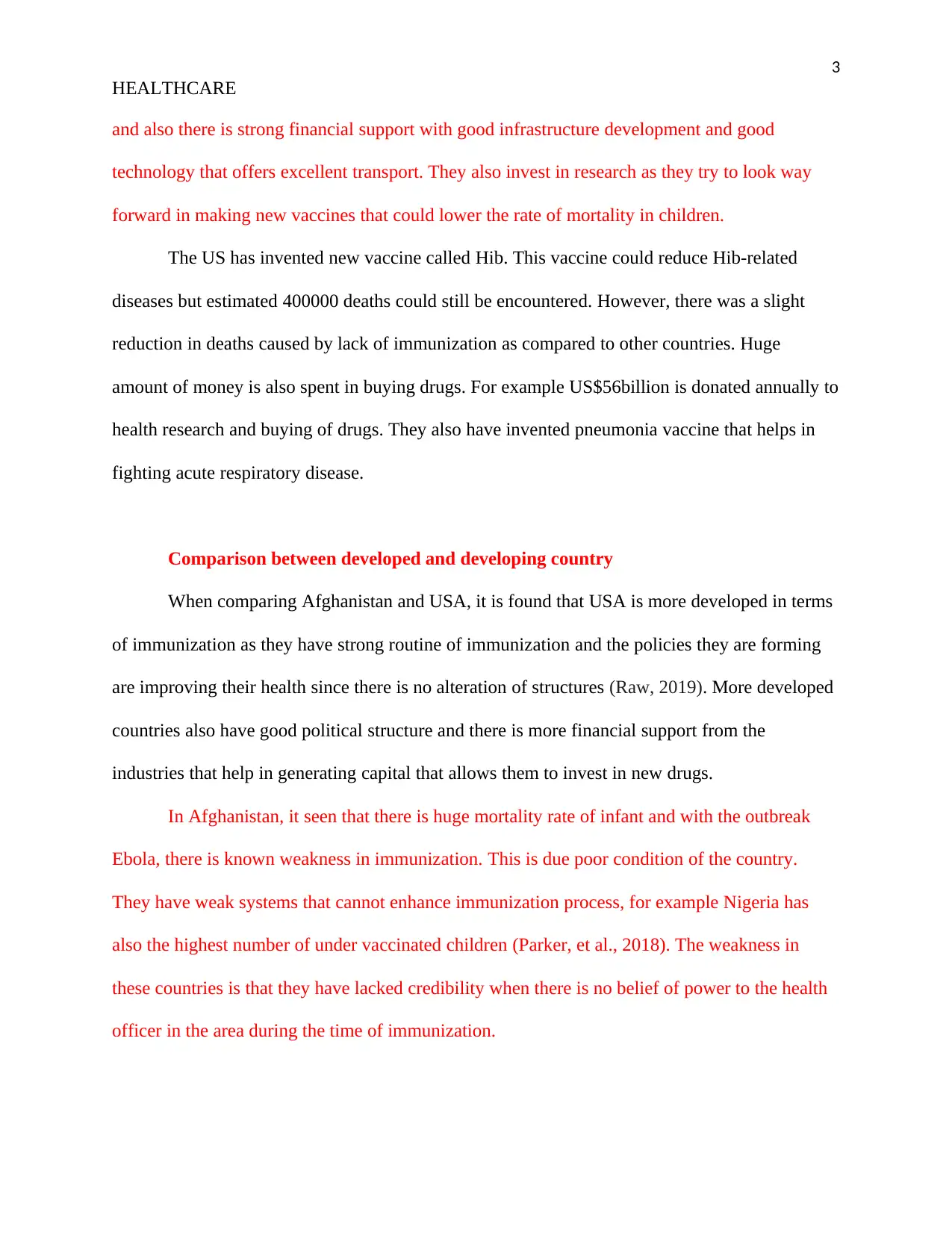
3
HEALTHCARE
and also there is strong financial support with good infrastructure development and good
technology that offers excellent transport. They also invest in research as they try to look way
forward in making new vaccines that could lower the rate of mortality in children.
The US has invented new vaccine called Hib. This vaccine could reduce Hib-related
diseases but estimated 400000 deaths could still be encountered. However, there was a slight
reduction in deaths caused by lack of immunization as compared to other countries. Huge
amount of money is also spent in buying drugs. For example US$56billion is donated annually to
health research and buying of drugs. They also have invented pneumonia vaccine that helps in
fighting acute respiratory disease.
Comparison between developed and developing country
When comparing Afghanistan and USA, it is found that USA is more developed in terms
of immunization as they have strong routine of immunization and the policies they are forming
are improving their health since there is no alteration of structures (Raw, 2019). More developed
countries also have good political structure and there is more financial support from the
industries that help in generating capital that allows them to invest in new drugs.
In Afghanistan, it seen that there is huge mortality rate of infant and with the outbreak
Ebola, there is known weakness in immunization. This is due poor condition of the country.
They have weak systems that cannot enhance immunization process, for example Nigeria has
also the highest number of under vaccinated children (Parker, et al., 2018). The weakness in
these countries is that they have lacked credibility when there is no belief of power to the health
officer in the area during the time of immunization.
HEALTHCARE
and also there is strong financial support with good infrastructure development and good
technology that offers excellent transport. They also invest in research as they try to look way
forward in making new vaccines that could lower the rate of mortality in children.
The US has invented new vaccine called Hib. This vaccine could reduce Hib-related
diseases but estimated 400000 deaths could still be encountered. However, there was a slight
reduction in deaths caused by lack of immunization as compared to other countries. Huge
amount of money is also spent in buying drugs. For example US$56billion is donated annually to
health research and buying of drugs. They also have invented pneumonia vaccine that helps in
fighting acute respiratory disease.
Comparison between developed and developing country
When comparing Afghanistan and USA, it is found that USA is more developed in terms
of immunization as they have strong routine of immunization and the policies they are forming
are improving their health since there is no alteration of structures (Raw, 2019). More developed
countries also have good political structure and there is more financial support from the
industries that help in generating capital that allows them to invest in new drugs.
In Afghanistan, it seen that there is huge mortality rate of infant and with the outbreak
Ebola, there is known weakness in immunization. This is due poor condition of the country.
They have weak systems that cannot enhance immunization process, for example Nigeria has
also the highest number of under vaccinated children (Parker, et al., 2018). The weakness in
these countries is that they have lacked credibility when there is no belief of power to the health
officer in the area during the time of immunization.
⊘ This is a preview!⊘
Do you want full access?
Subscribe today to unlock all pages.

Trusted by 1+ million students worldwide
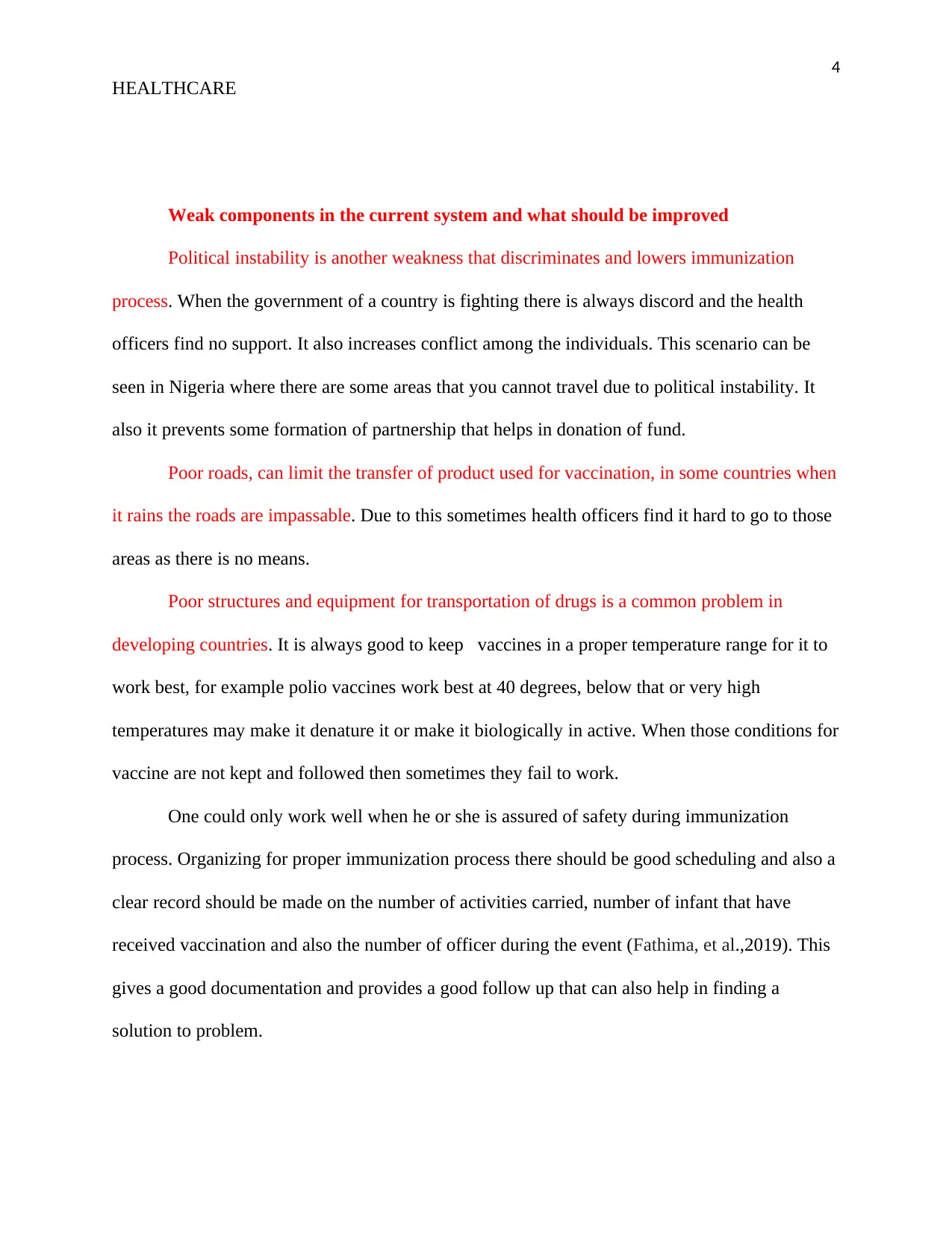
4
HEALTHCARE
Weak components in the current system and what should be improved
Political instability is another weakness that discriminates and lowers immunization
process. When the government of a country is fighting there is always discord and the health
officers find no support. It also increases conflict among the individuals. This scenario can be
seen in Nigeria where there are some areas that you cannot travel due to political instability. It
also it prevents some formation of partnership that helps in donation of fund.
Poor roads, can limit the transfer of product used for vaccination, in some countries when
it rains the roads are impassable. Due to this sometimes health officers find it hard to go to those
areas as there is no means.
Poor structures and equipment for transportation of drugs is a common problem in
developing countries. It is always good to keep vaccines in a proper temperature range for it to
work best, for example polio vaccines work best at 40 degrees, below that or very high
temperatures may make it denature it or make it biologically in active. When those conditions for
vaccine are not kept and followed then sometimes they fail to work.
One could only work well when he or she is assured of safety during immunization
process. Organizing for proper immunization process there should be good scheduling and also a
clear record should be made on the number of activities carried, number of infant that have
received vaccination and also the number of officer during the event (Fathima, et al.,2019). This
gives a good documentation and provides a good follow up that can also help in finding a
solution to problem.
HEALTHCARE
Weak components in the current system and what should be improved
Political instability is another weakness that discriminates and lowers immunization
process. When the government of a country is fighting there is always discord and the health
officers find no support. It also increases conflict among the individuals. This scenario can be
seen in Nigeria where there are some areas that you cannot travel due to political instability. It
also it prevents some formation of partnership that helps in donation of fund.
Poor roads, can limit the transfer of product used for vaccination, in some countries when
it rains the roads are impassable. Due to this sometimes health officers find it hard to go to those
areas as there is no means.
Poor structures and equipment for transportation of drugs is a common problem in
developing countries. It is always good to keep vaccines in a proper temperature range for it to
work best, for example polio vaccines work best at 40 degrees, below that or very high
temperatures may make it denature it or make it biologically in active. When those conditions for
vaccine are not kept and followed then sometimes they fail to work.
One could only work well when he or she is assured of safety during immunization
process. Organizing for proper immunization process there should be good scheduling and also a
clear record should be made on the number of activities carried, number of infant that have
received vaccination and also the number of officer during the event (Fathima, et al.,2019). This
gives a good documentation and provides a good follow up that can also help in finding a
solution to problem.
Paraphrase This Document
Need a fresh take? Get an instant paraphrase of this document with our AI Paraphraser
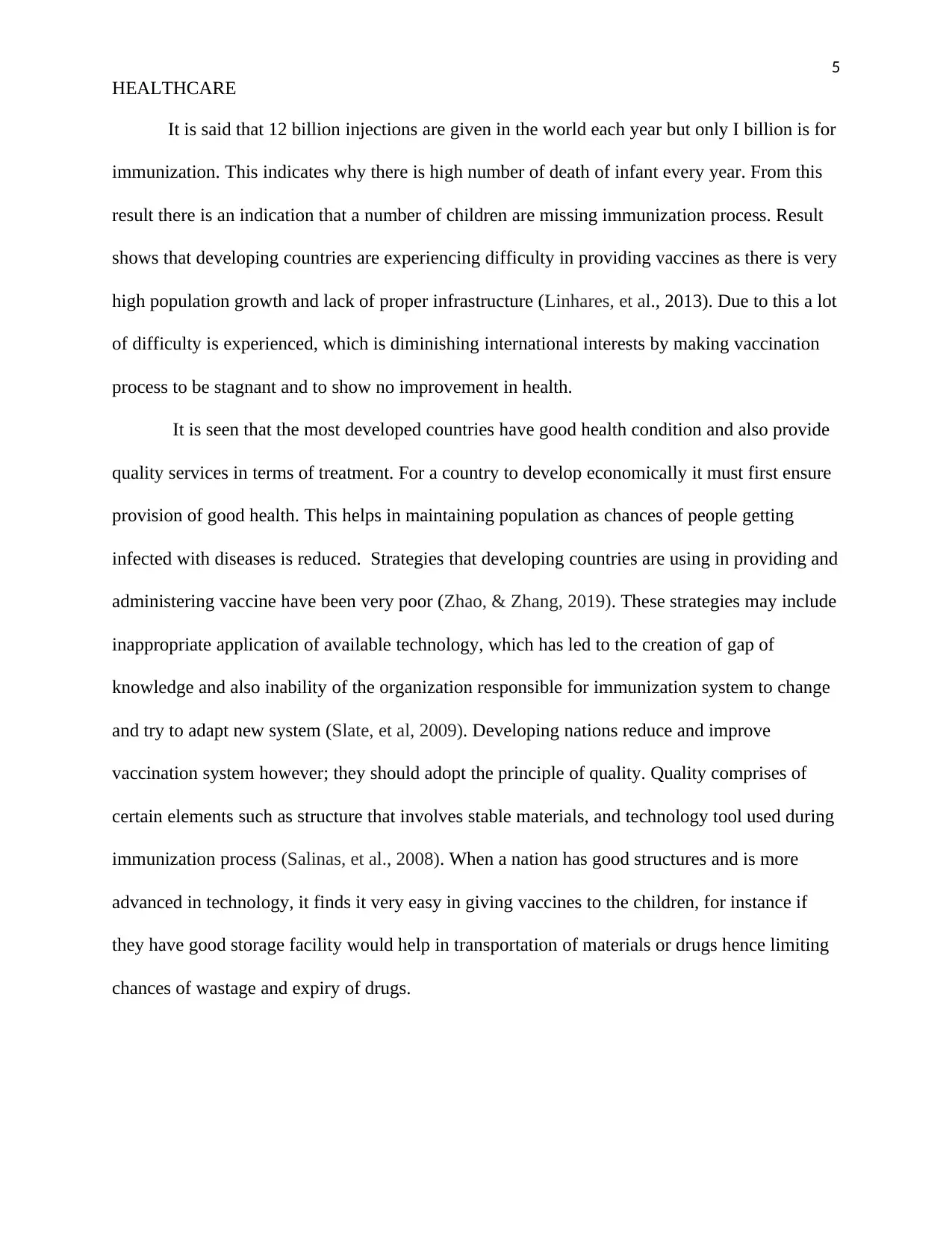
5
HEALTHCARE
It is said that 12 billion injections are given in the world each year but only I billion is for
immunization. This indicates why there is high number of death of infant every year. From this
result there is an indication that a number of children are missing immunization process. Result
shows that developing countries are experiencing difficulty in providing vaccines as there is very
high population growth and lack of proper infrastructure (Linhares, et al., 2013). Due to this a lot
of difficulty is experienced, which is diminishing international interests by making vaccination
process to be stagnant and to show no improvement in health.
It is seen that the most developed countries have good health condition and also provide
quality services in terms of treatment. For a country to develop economically it must first ensure
provision of good health. This helps in maintaining population as chances of people getting
infected with diseases is reduced. Strategies that developing countries are using in providing and
administering vaccine have been very poor (Zhao, & Zhang, 2019). These strategies may include
inappropriate application of available technology, which has led to the creation of gap of
knowledge and also inability of the organization responsible for immunization system to change
and try to adapt new system (Slate, et al, 2009). Developing nations reduce and improve
vaccination system however; they should adopt the principle of quality. Quality comprises of
certain elements such as structure that involves stable materials, and technology tool used during
immunization process (Salinas, et al., 2008). When a nation has good structures and is more
advanced in technology, it finds it very easy in giving vaccines to the children, for instance if
they have good storage facility would help in transportation of materials or drugs hence limiting
chances of wastage and expiry of drugs.
HEALTHCARE
It is said that 12 billion injections are given in the world each year but only I billion is for
immunization. This indicates why there is high number of death of infant every year. From this
result there is an indication that a number of children are missing immunization process. Result
shows that developing countries are experiencing difficulty in providing vaccines as there is very
high population growth and lack of proper infrastructure (Linhares, et al., 2013). Due to this a lot
of difficulty is experienced, which is diminishing international interests by making vaccination
process to be stagnant and to show no improvement in health.
It is seen that the most developed countries have good health condition and also provide
quality services in terms of treatment. For a country to develop economically it must first ensure
provision of good health. This helps in maintaining population as chances of people getting
infected with diseases is reduced. Strategies that developing countries are using in providing and
administering vaccine have been very poor (Zhao, & Zhang, 2019). These strategies may include
inappropriate application of available technology, which has led to the creation of gap of
knowledge and also inability of the organization responsible for immunization system to change
and try to adapt new system (Slate, et al, 2009). Developing nations reduce and improve
vaccination system however; they should adopt the principle of quality. Quality comprises of
certain elements such as structure that involves stable materials, and technology tool used during
immunization process (Salinas, et al., 2008). When a nation has good structures and is more
advanced in technology, it finds it very easy in giving vaccines to the children, for instance if
they have good storage facility would help in transportation of materials or drugs hence limiting
chances of wastage and expiry of drugs.
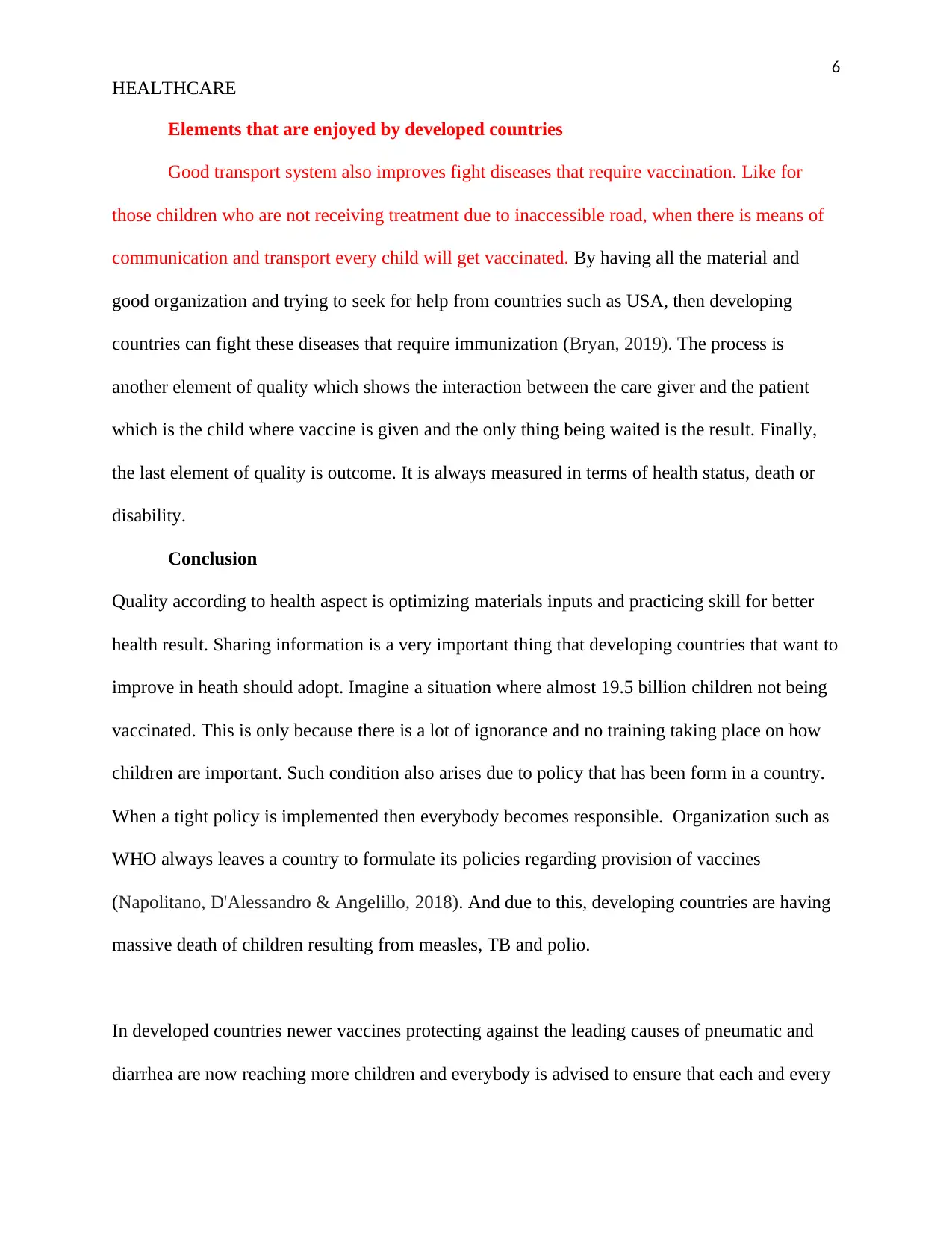
6
HEALTHCARE
Elements that are enjoyed by developed countries
Good transport system also improves fight diseases that require vaccination. Like for
those children who are not receiving treatment due to inaccessible road, when there is means of
communication and transport every child will get vaccinated. By having all the material and
good organization and trying to seek for help from countries such as USA, then developing
countries can fight these diseases that require immunization (Bryan, 2019). The process is
another element of quality which shows the interaction between the care giver and the patient
which is the child where vaccine is given and the only thing being waited is the result. Finally,
the last element of quality is outcome. It is always measured in terms of health status, death or
disability.
Conclusion
Quality according to health aspect is optimizing materials inputs and practicing skill for better
health result. Sharing information is a very important thing that developing countries that want to
improve in heath should adopt. Imagine a situation where almost 19.5 billion children not being
vaccinated. This is only because there is a lot of ignorance and no training taking place on how
children are important. Such condition also arises due to policy that has been form in a country.
When a tight policy is implemented then everybody becomes responsible. Organization such as
WHO always leaves a country to formulate its policies regarding provision of vaccines
(Napolitano, D'Alessandro & Angelillo, 2018). And due to this, developing countries are having
massive death of children resulting from measles, TB and polio.
In developed countries newer vaccines protecting against the leading causes of pneumatic and
diarrhea are now reaching more children and everybody is advised to ensure that each and every
HEALTHCARE
Elements that are enjoyed by developed countries
Good transport system also improves fight diseases that require vaccination. Like for
those children who are not receiving treatment due to inaccessible road, when there is means of
communication and transport every child will get vaccinated. By having all the material and
good organization and trying to seek for help from countries such as USA, then developing
countries can fight these diseases that require immunization (Bryan, 2019). The process is
another element of quality which shows the interaction between the care giver and the patient
which is the child where vaccine is given and the only thing being waited is the result. Finally,
the last element of quality is outcome. It is always measured in terms of health status, death or
disability.
Conclusion
Quality according to health aspect is optimizing materials inputs and practicing skill for better
health result. Sharing information is a very important thing that developing countries that want to
improve in heath should adopt. Imagine a situation where almost 19.5 billion children not being
vaccinated. This is only because there is a lot of ignorance and no training taking place on how
children are important. Such condition also arises due to policy that has been form in a country.
When a tight policy is implemented then everybody becomes responsible. Organization such as
WHO always leaves a country to formulate its policies regarding provision of vaccines
(Napolitano, D'Alessandro & Angelillo, 2018). And due to this, developing countries are having
massive death of children resulting from measles, TB and polio.
In developed countries newer vaccines protecting against the leading causes of pneumatic and
diarrhea are now reaching more children and everybody is advised to ensure that each and every
⊘ This is a preview!⊘
Do you want full access?
Subscribe today to unlock all pages.

Trusted by 1+ million students worldwide
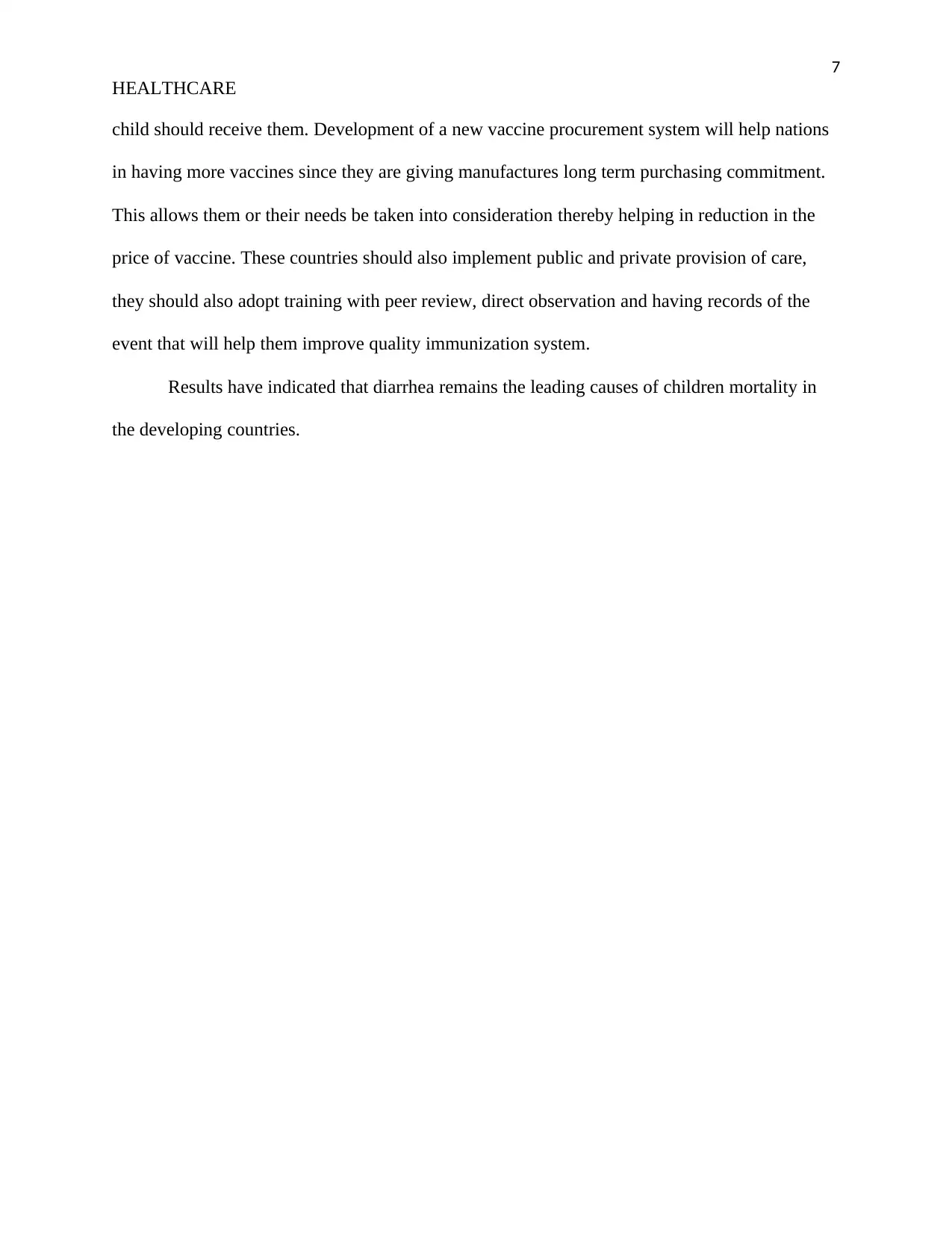
7
HEALTHCARE
child should receive them. Development of a new vaccine procurement system will help nations
in having more vaccines since they are giving manufactures long term purchasing commitment.
This allows them or their needs be taken into consideration thereby helping in reduction in the
price of vaccine. These countries should also implement public and private provision of care,
they should also adopt training with peer review, direct observation and having records of the
event that will help them improve quality immunization system.
Results have indicated that diarrhea remains the leading causes of children mortality in
the developing countries.
HEALTHCARE
child should receive them. Development of a new vaccine procurement system will help nations
in having more vaccines since they are giving manufactures long term purchasing commitment.
This allows them or their needs be taken into consideration thereby helping in reduction in the
price of vaccine. These countries should also implement public and private provision of care,
they should also adopt training with peer review, direct observation and having records of the
event that will help them improve quality immunization system.
Results have indicated that diarrhea remains the leading causes of children mortality in
the developing countries.
Paraphrase This Document
Need a fresh take? Get an instant paraphrase of this document with our AI Paraphraser
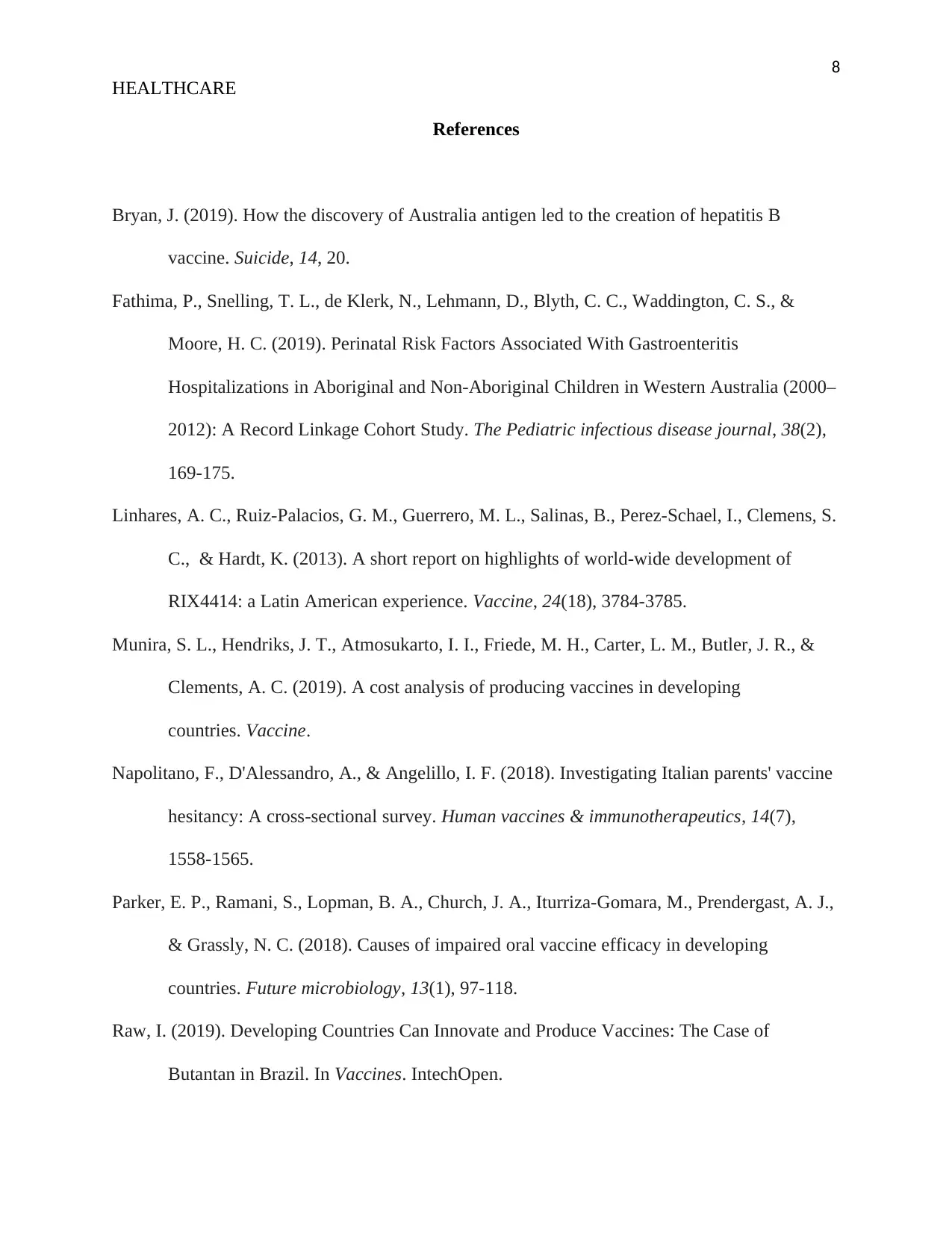
8
HEALTHCARE
References
Bryan, J. (2019). How the discovery of Australia antigen led to the creation of hepatitis B
vaccine. Suicide, 14, 20.
Fathima, P., Snelling, T. L., de Klerk, N., Lehmann, D., Blyth, C. C., Waddington, C. S., &
Moore, H. C. (2019). Perinatal Risk Factors Associated With Gastroenteritis
Hospitalizations in Aboriginal and Non-Aboriginal Children in Western Australia (2000–
2012): A Record Linkage Cohort Study. The Pediatric infectious disease journal, 38(2),
169-175.
Linhares, A. C., Ruiz-Palacios, G. M., Guerrero, M. L., Salinas, B., Perez-Schael, I., Clemens, S.
C., & Hardt, K. (2013). A short report on highlights of world-wide development of
RIX4414: a Latin American experience. Vaccine, 24(18), 3784-3785.
Munira, S. L., Hendriks, J. T., Atmosukarto, I. I., Friede, M. H., Carter, L. M., Butler, J. R., &
Clements, A. C. (2019). A cost analysis of producing vaccines in developing
countries. Vaccine.
Napolitano, F., D'Alessandro, A., & Angelillo, I. F. (2018). Investigating Italian parents' vaccine
hesitancy: A cross-sectional survey. Human vaccines & immunotherapeutics, 14(7),
1558-1565.
Parker, E. P., Ramani, S., Lopman, B. A., Church, J. A., Iturriza-Gomara, M., Prendergast, A. J.,
& Grassly, N. C. (2018). Causes of impaired oral vaccine efficacy in developing
countries. Future microbiology, 13(1), 97-118.
Raw, I. (2019). Developing Countries Can Innovate and Produce Vaccines: The Case of
Butantan in Brazil. In Vaccines. IntechOpen.
HEALTHCARE
References
Bryan, J. (2019). How the discovery of Australia antigen led to the creation of hepatitis B
vaccine. Suicide, 14, 20.
Fathima, P., Snelling, T. L., de Klerk, N., Lehmann, D., Blyth, C. C., Waddington, C. S., &
Moore, H. C. (2019). Perinatal Risk Factors Associated With Gastroenteritis
Hospitalizations in Aboriginal and Non-Aboriginal Children in Western Australia (2000–
2012): A Record Linkage Cohort Study. The Pediatric infectious disease journal, 38(2),
169-175.
Linhares, A. C., Ruiz-Palacios, G. M., Guerrero, M. L., Salinas, B., Perez-Schael, I., Clemens, S.
C., & Hardt, K. (2013). A short report on highlights of world-wide development of
RIX4414: a Latin American experience. Vaccine, 24(18), 3784-3785.
Munira, S. L., Hendriks, J. T., Atmosukarto, I. I., Friede, M. H., Carter, L. M., Butler, J. R., &
Clements, A. C. (2019). A cost analysis of producing vaccines in developing
countries. Vaccine.
Napolitano, F., D'Alessandro, A., & Angelillo, I. F. (2018). Investigating Italian parents' vaccine
hesitancy: A cross-sectional survey. Human vaccines & immunotherapeutics, 14(7),
1558-1565.
Parker, E. P., Ramani, S., Lopman, B. A., Church, J. A., Iturriza-Gomara, M., Prendergast, A. J.,
& Grassly, N. C. (2018). Causes of impaired oral vaccine efficacy in developing
countries. Future microbiology, 13(1), 97-118.
Raw, I. (2019). Developing Countries Can Innovate and Produce Vaccines: The Case of
Butantan in Brazil. In Vaccines. IntechOpen.
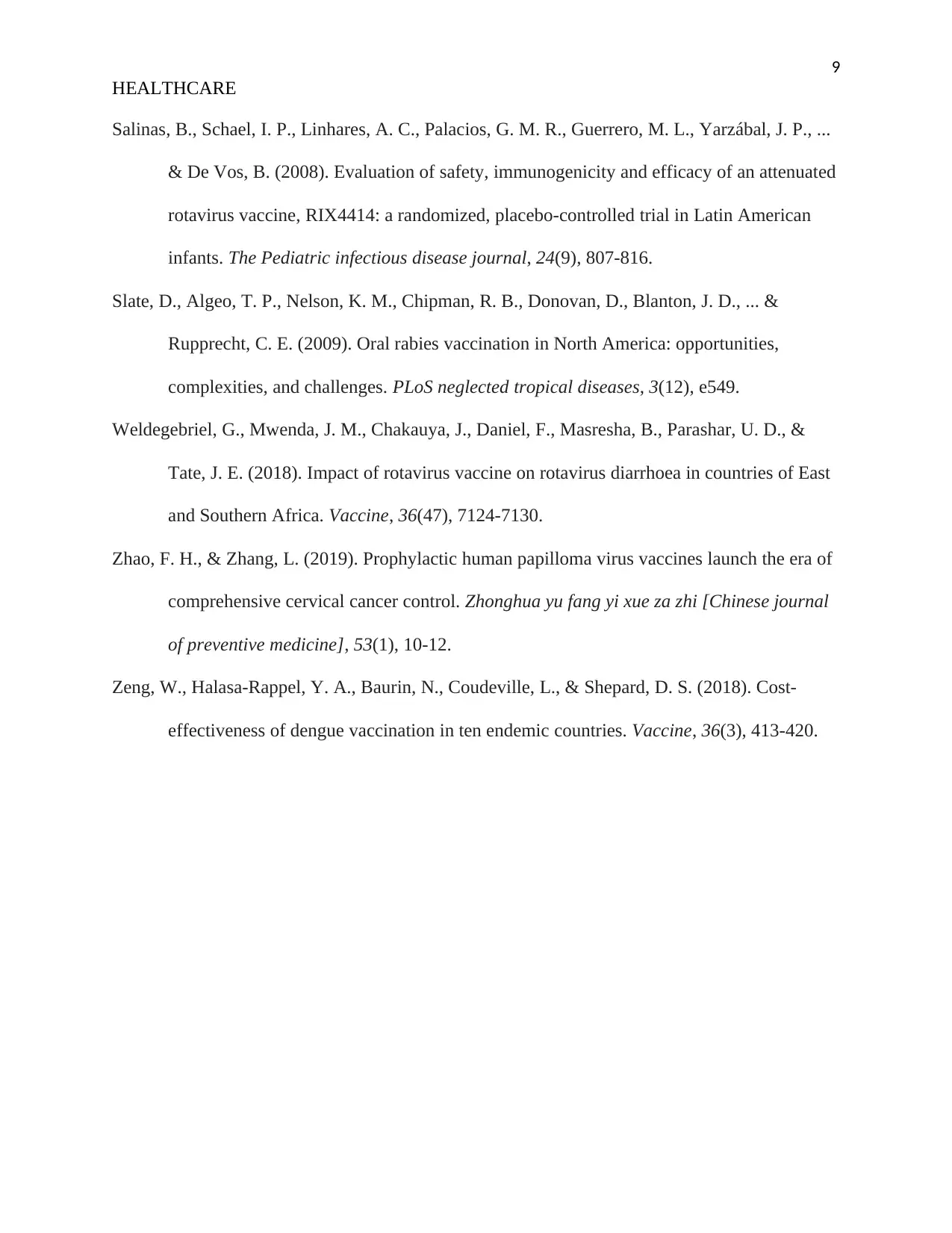
9
HEALTHCARE
Salinas, B., Schael, I. P., Linhares, A. C., Palacios, G. M. R., Guerrero, M. L., Yarzábal, J. P., ...
& De Vos, B. (2008). Evaluation of safety, immunogenicity and efficacy of an attenuated
rotavirus vaccine, RIX4414: a randomized, placebo-controlled trial in Latin American
infants. The Pediatric infectious disease journal, 24(9), 807-816.
Slate, D., Algeo, T. P., Nelson, K. M., Chipman, R. B., Donovan, D., Blanton, J. D., ... &
Rupprecht, C. E. (2009). Oral rabies vaccination in North America: opportunities,
complexities, and challenges. PLoS neglected tropical diseases, 3(12), e549.
Weldegebriel, G., Mwenda, J. M., Chakauya, J., Daniel, F., Masresha, B., Parashar, U. D., &
Tate, J. E. (2018). Impact of rotavirus vaccine on rotavirus diarrhoea in countries of East
and Southern Africa. Vaccine, 36(47), 7124-7130.
Zhao, F. H., & Zhang, L. (2019). Prophylactic human papilloma virus vaccines launch the era of
comprehensive cervical cancer control. Zhonghua yu fang yi xue za zhi [Chinese journal
of preventive medicine], 53(1), 10-12.
Zeng, W., Halasa-Rappel, Y. A., Baurin, N., Coudeville, L., & Shepard, D. S. (2018). Cost-
effectiveness of dengue vaccination in ten endemic countries. Vaccine, 36(3), 413-420.
HEALTHCARE
Salinas, B., Schael, I. P., Linhares, A. C., Palacios, G. M. R., Guerrero, M. L., Yarzábal, J. P., ...
& De Vos, B. (2008). Evaluation of safety, immunogenicity and efficacy of an attenuated
rotavirus vaccine, RIX4414: a randomized, placebo-controlled trial in Latin American
infants. The Pediatric infectious disease journal, 24(9), 807-816.
Slate, D., Algeo, T. P., Nelson, K. M., Chipman, R. B., Donovan, D., Blanton, J. D., ... &
Rupprecht, C. E. (2009). Oral rabies vaccination in North America: opportunities,
complexities, and challenges. PLoS neglected tropical diseases, 3(12), e549.
Weldegebriel, G., Mwenda, J. M., Chakauya, J., Daniel, F., Masresha, B., Parashar, U. D., &
Tate, J. E. (2018). Impact of rotavirus vaccine on rotavirus diarrhoea in countries of East
and Southern Africa. Vaccine, 36(47), 7124-7130.
Zhao, F. H., & Zhang, L. (2019). Prophylactic human papilloma virus vaccines launch the era of
comprehensive cervical cancer control. Zhonghua yu fang yi xue za zhi [Chinese journal
of preventive medicine], 53(1), 10-12.
Zeng, W., Halasa-Rappel, Y. A., Baurin, N., Coudeville, L., & Shepard, D. S. (2018). Cost-
effectiveness of dengue vaccination in ten endemic countries. Vaccine, 36(3), 413-420.
⊘ This is a preview!⊘
Do you want full access?
Subscribe today to unlock all pages.

Trusted by 1+ million students worldwide
1 out of 9
Related Documents
Your All-in-One AI-Powered Toolkit for Academic Success.
+13062052269
info@desklib.com
Available 24*7 on WhatsApp / Email
![[object Object]](/_next/static/media/star-bottom.7253800d.svg)
Unlock your academic potential
Copyright © 2020–2025 A2Z Services. All Rights Reserved. Developed and managed by ZUCOL.




